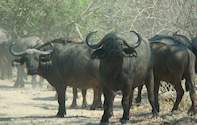
A foot and mouth symposium held on August 24 and 25, 2005 will result in the formation of a committee containing all the major role players who are affected by the placement of the foot and mouth zones in the Tzaneen/Phalaborwa area.
The symposium was the first to draw together a wide range of stakeholders, including government, commercial farmers, communal farmers, the tourism sector, exporters and security authorities.
The committee will enlighten the debate into where the new zones will be placed, hopefully satisfying any grievances that have been caused by previous movements of the zones. According to Dr Dewald Keet, the Office International des Epizooties (OIE), which dictates foot and mouth control guidelines for the World Trade Organisation, is likely to give the region a bit more time to determine if and where the foot and mouth control zones are moved to.
The decision was initially intended to be made in early September. The movement of the foot and mouth zones became a hot issue after last year's foot and mouth outbreak, which saw extensive measures being put into place to contain the outbreak. The organisers of the symposium had the stated aim of limiting the risk of the disease breaking out again in future.
Keet gave a presentation at the symposium, enlightening the other attendees about the problems that the state veterinary authorities have been facing over the maintenance of the Kruger National Park (KNP) fence.
Keizer Mdluli also presented on the problems faced at Letaba Ranch. Keet highlighted factors such as how the closure of almost half of the park's windmill-driven artificial waterpoints has affected where the KNP's ever-increasing elephant population looks for water, putting stress on disease-control fences.
He described how the construction of the fence has changed over time, and the implications this has had for fence repair times. One problem is that this year alone, 2,000 Mozambicans have crossed the electric fence, shorting it out and encouraging elephants and other animals to risk tackling the fence. New fences are being erected in highpressure zones using cables instead of electricity to keep elephants in, at a cost of R200,000 per kilometre.
Poor fence repair has in the past resulted in domestic animals and wild game mingling, allowing the foot and mouth virus to spread out of infected zones into buffer and surveillance zones. The spread of the disease has serious implications for both local and international trade, and commercial farmers may suffer financially if the infected zone increases in size.
Foot and mouth is a highly contagious viral disease that affects cloven-hoofed animals like cows and pigs, as well as wild animals. It is controlled through the use of zones, between which restrictions are placed on animal movements. The zones include the infected zone, buffer zone, surveillance zone and the free zone, where no foot and mouth occurs.

